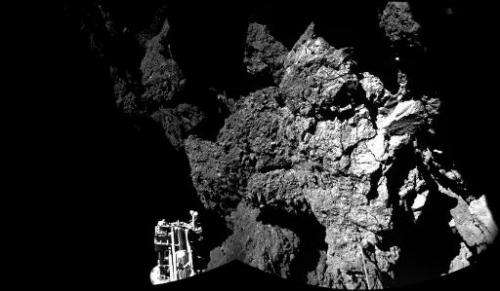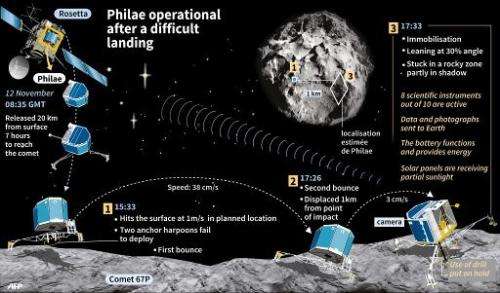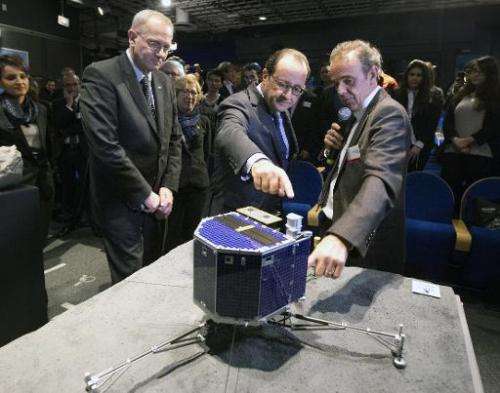Philae probing comet with hours left on battery

Europe's probe Philae was busily conducting experiments on a comet 510 million kilometres (320 million miles) from Earth with just hours of onboard battery life left, ground control reported of signals received Friday.
The lander had bounced twice after its initial touchdown Wednesday, ending up in a mystery location. Data from aboard revealed it landed at an angle with one leg dangling, likely in a crevice shadowed from battery-boosting sunlight.
"Good morning, Earth!" said a tweet in the name of the robot lab on Day Two of its stay on comet 67P/Churyumov-Gerasimenko, which is racing towards the Sun at 18 kilometres (11 miles) per second.
"It's been a busy night at #67P! Now that I'm back in touch with my team, I'll tell you all about it!" said the message.
Washing machine-sized Philae landed on the comet after a nail-biting seven-hour, 20-km descent from its orbiting mothership Rosetta, which had travelled more than a decade and 6.5 billion kilometres (four billion miles) to get there.
The touchdown on the low-gravity comet did not go entirely according to plan, when Philae's duo of anchoring harpoons failed to deploy and it lifted off again... twice.
Philae ended up shadowed from sunlight—receiving only 1.5 hours per day instead of the six or seven required to fully recharge its batteries.
The lab landed with about 60 hours of onboard power as well as solar panels to try and extend the mission duration by as much as possible.

Ground controllers are still working out how much power exactly Philae may still get from the feeble sunlight. A media briefing has been scheduled for 1300 GMT Friday.
Its rough start has not stopped Philae from experimenting more or less as planned, and relaying valuable data to Earth via Rosetta—with which it has two communications windows per day.
When contact was reestablished Friday morning, Philae reported progress with two experiments—one dubbed MUPUS which uses sing external sensors to measure the density and temperature of the comet surface, and the other a spectrometer called APXS to test its composition.
In good shape
"Last night MUPUS & APXS got to work! My team is currently checking how they did," said a tweet from @Philae2014.
"Philae is in good shape. It is working full-out," added astrophysicist Philippe Gaudon, who heads the Rosetta mission at French space agency CNES.
"It is not doing exactly what we had hoped, of course, but we have changed the onboard programming" to adapt to the conditions, he told AFP.

It was not clear whether Philae would be able to deploy a drill, one of its 10 onboard experiments, to take sub-surface comet samples for chemical testing.
Trying to activate the drill with the 100-kilogramme (22-pound) lander balanced precariously on a steep slope could tip it over.
Without drilling, "we should harvest at least 70 to 80 percent of the scientific data we had expected from Philae's first (battery-powered) phase," said Gaudon.
The mission has already yielded some amazing finds, including sending home the first-ever photos taken from the surface of a comet—a highlight achievement in the European Space Agency's flagship 1.3-billion-euro ($1.6-billion) project.
The Rosetta mission aims to unlock the secrets that comets, primordial clusters of ice and dust, are thought to hold about how the Solar System was formed around 4.6 billion years ago.
Some scientists theorise that comets may even have "seeded" Earth with some of the ingredients for life.
Rosetta, with Philae riding piggyback, was hoisted into space in 2004, and reached its target in August this year, having used the gravitational pull of Earth and Mars as slingshots to build up speed.
© 2014 AFP




















